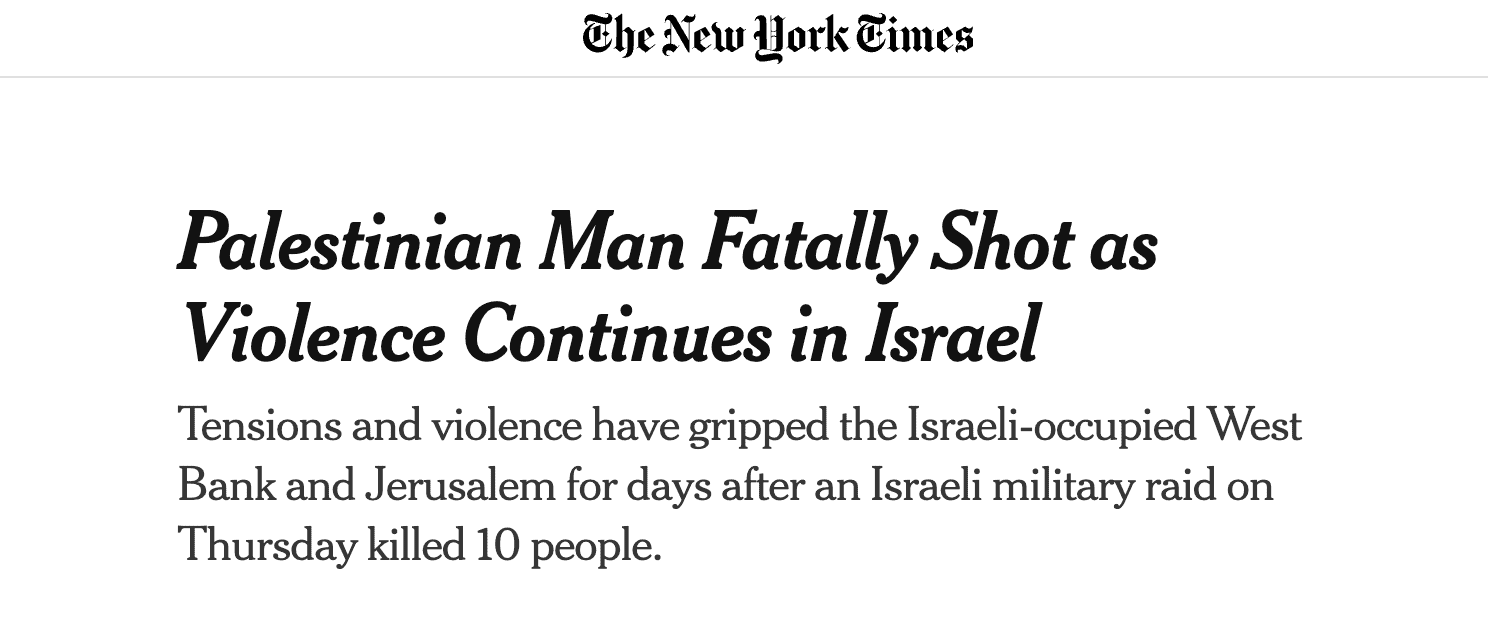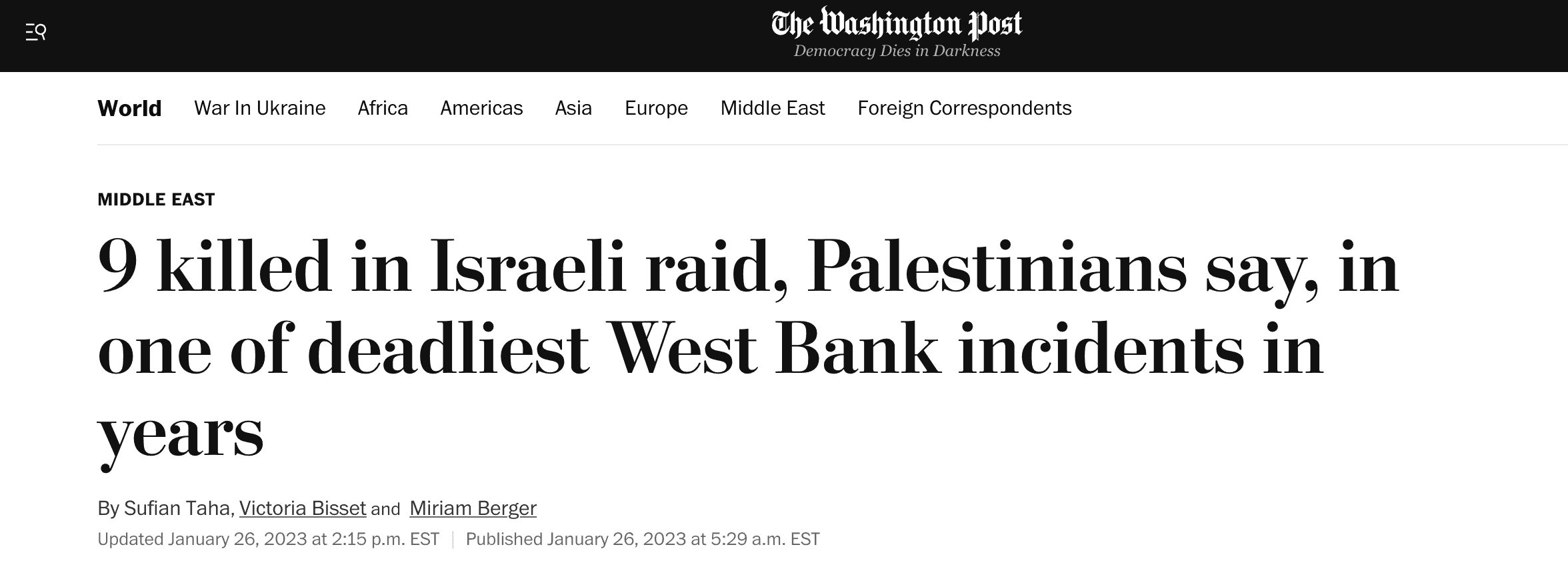The headline is undoubtedly the most important element of a news story. In a few words, it should both summarize the piece and grab the reader’s attention.
The headline may also be the only part of the story that gets read given the fact that studies indicate nearly 50 percent of news consumers scan the headline and little else.
It is, therefore, concerning to see how some of the world’s largest and most influential media outlets use headlines to distort the truth and further a specific narrative with regard to acts of violence, terrorism and security issues in Israel.
The ‘Deserving’ Victims: Murder of Two Israeli Brothers
The murder of Hallel Yaniv and Yagel Yaniv by a Hamas terrorist as they were driving through the West Bank village of Huwara triggered a revenge riot that was widely condemned by Israeli politicians.
Prior to and following the violent scenes witnessed in the flashpoint village last month, several news outlets opted to frame the killing of the siblings in a profoundly disturbing way.
CNN was among those to provide a tacit justification for their murder, specifically by describing the brothers as “settlers” in its headline and tying their deaths as a response to an Israeli counterterrorism raid:

Such reportage is part of a pattern whereby CNN includes in its headlines whether a perpetrator is a “settler,” but fails to note the identities of attackers who are Palestinian:

The New York Times did not devote a story solely to the murder of the brothers, but identified them as “settlers” in subsequent reports about the resulting mob violence:

Concealing Identities: Jerusalem Car-Ramming Terror Attack
On Friday, February 10, a Palestinian terrorist from eastern Jerusalem rammed his car into a crowd of civilians waiting at a bus stop in the Ramot neighborhood of Jerusalem.
The subsequent reports about the horrific attack exposed the difference in how media outlets treat Jewish victims of terrorism compared to Palestinian deaths when composing headlines.
The New York Times published two articles online about the terror attack:


Despite the fact that the nature of the attack was clear from the outset, the publication failed to note the background of either the attacker or the victims in its initial headline.
Rather than inform readers that the driver was a Palestinian who had deliberately targeted a crowd of visibly Jewish bystanders, the NYT opted to leave out these key details.
Additionally, the second story — when further details of the attack had been established — also failed to note that the victims were Jewish Israelis.
Compare this to the NYT’s coverage of the death of a Palestinian man who was armed with a handgun:

Also guilty of obscuring details of the perpetrator and victims of the Jerusalem attack was CNN:

It is helpful to contrast the headline with another CNN story that was published on the very same day and where CNN clearly thought it was relevant to note how the victim was a Palestinian and the shooter was an “Israeli settler”:

Distorting Anti-Terror West Bank Raids
In recent months, Israel has conducted a series of raids in several West Bank cities, including Nablus and Jenin, to arrest suspected terrorists and thwart planned attacks on Israeli civilians.
Yet, several media outlets were seemingly reluctant to reveal that the majority of Palestinians who were killed during one raid in Jenin were militants belonging to Islamic Jihad and died during gunfights with Israeli security forces.
The Washington Post, for example, failed to note that the raid was expressly targeting militants who were planning an imminent terror attack:

Meanwhile, the Guardian opted for an even more nondescript headline that did not include any mention of the purpose of the raid or the militant backgrounds of the Palestinians who died:

The ‘Deadliest Year’: Framing the Palestinian Death Toll
Numerous media organizations reported on a claim from the United Nations that 2022 had been the deadliest year for Palestinians in the West Bank and eastern Jerusalem in more than a decade.
However, as HonestReporting detailed, these numbers failed to acknowledge that most Palestinians who died were killed while attacking Israelis, in addition to the fact that almost half of the deaths were publicly claimed as members of recognized terror groups, including Hamas, Islamic Jihad, and the Al Aqsa Martyrs’ Brigades.
The Washington Post and NBC News were among the outlets that covered the UN’s misleading data:


While both articles made reference to the Israeli death toll, neither included the fact that 2022 was also one of the deadliest years for Israelis.
According to data from the Shin Bet security agency, a total of 27 citizens and foreign nationals died in attacks perpetrated by Palestinian or Arab-Israeli terrorists.
Shaping the Narrative
The above are just a handful of examples relating to several news events of how the mainstream media uses its headlines to manipulate the facts and, ultimately, mold readers’ perceptions of events in Israel.
But these examples serve as a reminder of why the public should always beware of the headline — it rarely gives the full story.
Liked this article? Follow HonestReporting on Twitter, Facebook, Instagram and TikTok to see even more posts and videos debunking news bias and smears, as well as other content explaining what’s really going on in Israel and the region.
New! Skip the social scroll and get the latest from HonestReporting via Telegram.



